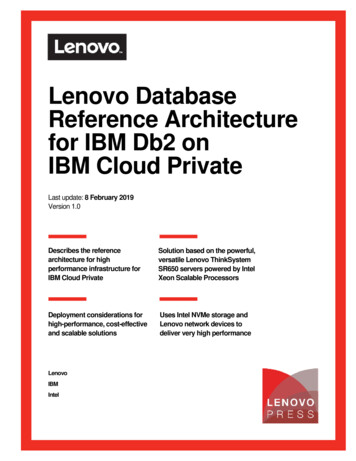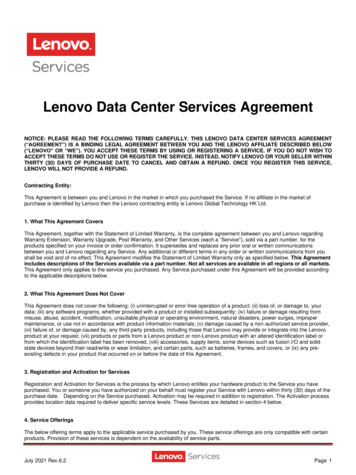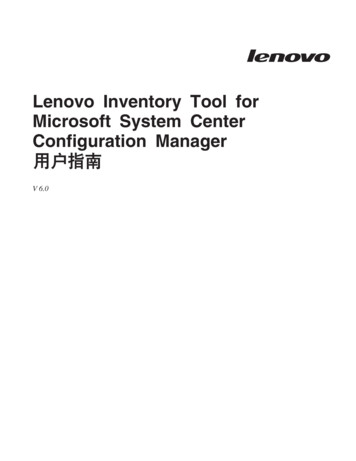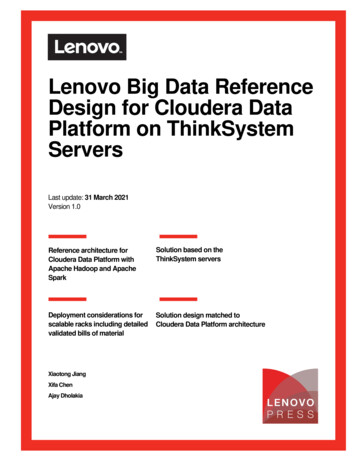
Transcription
Lenovo DatabaseReference Architecturefor IBM Db2 onIBM Cloud PrivateLast update: 8 February 2019Version 1.0Describes the referencearchitecture for highperformance infrastructure forIBM Cloud PrivateSolution based on the powerful,versatile Lenovo ThinkSystemSR650 servers powered by IntelXeon Scalable ProcessorsDeployment considerations forhigh-performance, cost-effectiveand scalable solutionsUses Intel NVMe storage andLenovo network devices todeliver very high performanceLenovoIBMIntelClick here to check for updates
Table of Contents1Introduction . 12Business problem and business value. 232.1Business problem . 22.2Business value . 2Requirements . 33.1Functional requirements . 33.2Non-functional requirements . 34Architectural overview . 45Component model . 55.16Operational model . 76.1Hardware description . 76.1.1Lenovo ThinkSystem SR650 Server . 76.1.2Lenovo RackSwitch G8052 . 86.1.3Lenovo RackSwitch G8272 . 86.1.4Lenovo RackSwitch NE2572 . 96.1.5Lenovo RackSwitch NE10032 . 106.27IBM Cloud Private Components . 5Cluster nodes . 106.2.1Node Types .116.2.2Node Hardware Configuration . 126.2.3Cluster Sizes. 146.3IBM Cloud Private software stack . 146.4Systems management . 156.5Networking . 166.5.1Data Network . 176.5.2Hardware Management network . 176.5.310Gb and 25Gb Data Network Configurations . 18Deploying VMware vSphere . 19iiLenovo Database Reference Architecture for IBM Db2 on IBM Cloud Private
7.1vSphere Configuration . 197.2vSphere Distributed Switch . 217.2.1Network Architecture . 217.2.2Management Network . 227.38Deploying IBM Cloud Private . 248.1Cluster Monitoring . 248.1.1Logging . 248.1.2Monitoring and Alerting . 258.1.3Metering . 268.29VMware vSAN configuration . 23Network Configurations - IBM Cloud Private . 27Deploying IBM Db2 . 299.1Estimating cluster size . Error! Bookmark not defined.9.2High availability considerations . 2910 Acknowledgements . 31Resources . 32Document history . 33iiiLenovo Database Reference Architecture for IBM Db2 on IBM Cloud Private
1 IntroductionThis document describes the reference architecture for the IBM Cloud Private solution. It provides apredefined and optimized hardware infrastructure for high performance implementation of the IBM CloudPrivate software. It also provides an example of deploying the IBM Db2 package on IBM Cloud Private. Thisreference architecture provides planning, design considerations, and best practices for implementing IBMCloud Private with Lenovo and Intel products.Lenovo, IBM and Intel teams worked together on this document and the reference architecture describedherein was developed and validated in a joint engineering project.Container-based architectures have become increasingly attractive to modern businesses that want todigitally transform their data centers with a modern application and technology infrastructure. Containersprovide a lightweight complement to virtual machines (VMs) that are portable, run anywhere, are fast andeasy to deploy, and can support both traditional apps and microservices. Containers are also attractive from abusiness perspective because they can be used with VMs to reduce hardware, licensing, and maintenancecosts, accelerate time to market, increase productivity, and enable hybrid clouds.The Lenovo validated design for IBM Cloud Private enables IT organizations to deploy a container solutioncost effectively, quickly, and without adding complexity. The combination of IBM Cloud Private and VMwarevSAN on Lenovo ThinkSystem hardware can provide an economical, enterprise-grade way forward for digitaltransformation. In addition, the validated design's performance-optimized infrastructure is built on Intel XeonScalable processors, Intel 3D NAND SSDs, Intel Optane DC SSDs, and the Intel Ethernet 700 Series networkadapters.The intended audience of this document is IT professionals, technical architects, sales engineers, andconsultants to assist in planning, designing, and implementing the big data solution with Lenovo hardware. Itis assumed that you are familiar with virtualization and data warehouse concepts. For more information, see“Resources” on page 32.1Lenovo Database Reference Architecture for IBM Db2 on IBM Cloud Private
2 Business problem and business valueThis section describes business challenges faced by big data environments and the value provided by theIBM Cloud Private solution used to address the business challenges.2.1 Business problemCloud computing has become pervasive for providing data analytic and storage capabilities in a managedenvironment that can be scaled elastically as business needs change. The public cloud, available as aservice, provides efficiency and rapid provisioning for business applications; but organizations in many casescannot run their applications on the public cloud. Most of the time they are held back by regulatory and legalrequirements. Others do not want their strategic assets to leave their organization. Private cloud can bringthe benefits of a public cloud to your on-premises infrastructure and keep it behind your firewall. A privatecloud is like a fenced-in backyard with a gate to surround properties and public spaces. It can give you manyof the benefits of a public cloud with the additional control and security of dedicated resources.2.2 Business valueIBM Cloud Private offers similar benefits to a public cloud but is dedicated to a single organization, allowingcustomization of the environment to meet personalized needs and security requirements. It can be managedinternally or by a third party and it can be hosted behind the company firewall or externally. This platformoffers public cloud advantages while providing the increased performance, predictable costs, tighter securityand flexible management options found in a private cloud.The IBM Cloud Private offering extends directly from IBM's experience with cloud-native infrastructure andapplications. The principles that guide the IBM Cloud Private platform are: Enterprise-focused platform using microservices - many of the advantages of microservices comefrom resource isolation, scale up and scale down, and lightweight, portable movement of applicationworkloads. Application services - runtimes, middleware, data and other value-added services can be added tocloud-native applications or connected to existing applications. IBM Cloud Private makes it easier tostand up an elastic runtime that is based on a variety of workloads.2Lenovo Database Reference Architecture for IBM Db2 on IBM Cloud Private
3 RequirementsThe functional and non-functional requirements for this reference architecture are described in this section.3.1 Functional requirementsA private cloud solution for big data analytics supports the following key functional requirements: Ability to optimize applications for the cloud Open data centers to work with cloud services Create new cloud native applications3.2 Non-functional requirementsCustomers require their cloud private infrastructure to be easy, dependable, and fast. The following nonfunctional requirements are key: 3Easy:oEase of developmentoEasy management at scaleoAdvanced job managementoEasy to access data by various user typesDependable:oData protection with snapshot and mirroringoAutomated self-healingoInsight into software/hardware health and issuesoHigh availability (HA) and business continuityFast:oSuperior performanceoScalabilitySecure and governed:oStrong authentication and authorizationoPhysical and firewall securityoData confidentiality and integrityLenovo Database Reference Architecture for IBM Db2 on IBM Cloud Private
4 Architectural overviewThe IBM private cloud solution is based on a flexible and scalable architecture. The primary hardware buildingblock is the worker node implemented on Lenovo ThinkSystem SR650 servers. A cluster of SR650 serversare connected together to meet the desired total compute and storage capacity required to deliver the bestperformance for IBM Cloud Private solutions.Figure 1 shows the architecture overview of the IBM Cloud Private reference architecture that uses LenovoThinkSystem hardware infrastructure.Figure 1. IBM Cloud Private architecture overview.The private cloud architecture delivers several key functions: Container orchestration based on Kubernetes - this layer provides cluster management, securitycapabilities, image repositories, routing services, and microservices mesh. A PaaS layer to provide higher-level runtimes and service bindings for an easier developmentexperience. The CaaS and PaaS layer, which sit over an infrastructure layer to provide compute through virtualmachines, network, storage, and security. Automation and orchestration for the underlying infrastructure to provide predefined infrastructuretemplates to create repeatable patterns. Monitoring for container-based applications to provide logging, dashboards, and automation. Itsupports network and storage policy-based controls for application isolation and security, andautomated application health checking and recovery from failures. The ability to run containerized workloads for several patterns, such as cloud-native, data workloads,integration workloads, tool workloads, and some middleware, such as Java Application Server. 4A workloads catalog that you can provision via containers to automate the development experience.Lenovo Database Reference Architecture for IBM Db2 on IBM Cloud Private
5 Component modelThis section describes the high-level component model of the IBM Cloud Private solution shown in thefollowing diagram. By supporting Kubernetes and Cloud Foundry, IBM Cloud Private provides choices inapplication development such as content that can be containerized, tools for end-to-end automation, andmanagement tools.Figure 2. IBM Cloud Private component model overview.5.1 IBM Cloud Private ComponentsSeveral primary components of the IBM Cloud Private solution are described below: Kubernetes - IBM Cloud Private provides an open container platform based on Kubernetes forautomating deployment, scaling, and management of containerized applications. It groupscontainers that make up an application into logical units for easy management and discovery. Docker - Docker containers provide lightweight, standalone, executable software packages witheverything needed to run an application, regardless of the infrastructure or operating system. In IBMCloud Private, a private Docker registry integrates with the Docker registry V2 API to provide a localregistry service that functions in the same way as the cloud-based registry service, Docker Hub. Thislocal registry has all the same features as Docker Hub, but you can restrict which users can view orpull images from this registry. Helm - Helm is the Kubernetes native package management system and is used for applicationmanagement inside an IBM Cloud Private cluster. The Helm GitHub community curates andcontinuously expands a set of tested and preconfigured Kubernetes applications. You can add items5Lenovo Database Reference Architecture for IBM Db2 on IBM Cloud Private
from this catalog of stable applications to your cluster from the management console. Installing thisHelm community catalog provides an extra 80 Kubernetes applications that are ready fordeployment in your cluster. IBM Cloud Automation Manager - IBM Cloud Automation Manager is a multi-cloud, self-servicemanagement platform running on IBM Cloud Private that empowers developers and administrators tomeet business demands. This platform allows you to efficiently manage and deliver services throughend-to-end automation while enabling developers to build applications aligned with enterprisepolicies. IBM Cloud Private Catalog - IBM Cloud Private provides an easy to use, extend, and composeCatalog of IBM and third-party content. The Catalog provides a centralized location from which youcan browse for and install packages in your cluster. Packages for additional IBM products areavailable from curated repositories that are included in the default IBM Cloud Private repository listwhich is available via an internet connection. IBM Db2 - Db2 Database and Db2 Warehouse includes products for operational databases, datawarehouses, data lakes and fast data. These databases and data warehouses support best-in-classand open-source software. Cloud Foundry - Cloud Foundry is open source software that makes it faster and easier to build, test,deploy and scale applications, providing a choice of clouds, developer frameworks, and applicationservices. It is available through a variety of private cloud distributions and public cloud instances. VMware - is a leading virtual machine software provider which powers a large number of worldwideon-premises and cloud platforms. VMware virtualization increases utilization of hardware resourceswhile giving easy provisioning of software platforms onto the hardware. Grafana - is open source software that allows you to query, visualize, create alerts on data metricswhere ever they are stored. One can create, explore, and share dashboards that provide an easy touse analytics platform for data metrics.6Lenovo Database Reference Architecture for IBM Db2 on IBM Cloud Private
6 Operational modelThis section describes the hardware infrastructure aspects of the IBM Cloud Private reference architecture.To support different customer environments, different configurations are provided for supporting differentamounts of data sizes and performance levels.6.1 Hardware descriptionThis reference architecture uses Lenovo servers SR650 (2U) servers and Lenovo RackSwitch G8052 andG8272 top of rack switches.6.1.1 Lenovo ThinkSystem SR650 ServerThe Lenovo ThinkSystem SR650 is an ideal 2-socket 2U rack server for small businesses up to largeenterprises that need industry-leading reliability, management, and security, as well as maximizingperformance and flexibility for future growth. The SR650 server is particularly suited for big data applicationsdue to its rich internal data storage, large internal memory and selection of high performance Intel processors.It is also designed to handle general workloads, such as databases, virtualization and cloud computing, virtualdesktop infrastructure (VDI), enterprise applications, collaboration/email, and business analytics.The SR650 server supports: Up to two Intel Xeon Scalable Processors Up to 1.5 TB 2666 MHz TruDDR4 memory (support for up to 3 TB is planned for future), Up to 24x 2.5-inch or 14x 3.5-inch drive bays with an extensive choice of NVMe PCIe SSDs,SAS/SATA SSDs, and SAS/SATA HDDs Flexible I/O Network expansion options with the LOM slot, the dedicated storage controller slot, andup to 6x PCIe slotsFigure 3. Lenovo ThinkSystem SR650Combined with the Intel Xeon Scalable Processors (Bronze, Silver, Gold, and Platinum), the Lenovo SR650server offers an even higher density of workloads and performance that lowers the total cost of ownership(TCO). Its pay-as-you-grow flexible design and great expansion capabilities solidify dependability for any kindof workload with minimal downtime.The SR650 server provides high internal storage density in a 2U form factor with its impressive array ofworkload-optimized storage configurations. It also offers easy management and saves floor space and powerconsumption for most demanding use cases by consolidating storage and server into one system.7Lenovo Database Reference Architecture for IBM Db2 on IBM Cloud Private
This reference architecture recommends the storage-rich ThinkSystem SR650 for the following reasons: Storage capacity: Each of the 14 configured 3.5-inch drives has raw capacity up to 10 TB and each,providing for 140 TB of raw storage per node and over 2000 TB per rack. Performance: This hardware supports the latest Intel Xeon Scalable processors and TruDDR4Memory. Flexibility: Server hardware uses embedded storage, which results in simple scalability (by addingnodes). PCIe slots: Up to 7 PCIe slots are available if rear disks are not used, and up to 3 PCIe slots if theRear HDD kit is used. They can be used for network adapter redundancy and increased networkthroughput. Higher power efficiency: Titanium and Platinum redundant power supplies can deliver 96%(Titanium) or 94% (Platinum) efficiency at 50% load. Reliability: Outstanding reliability, availability, and serviceability (RAS) improve the businessenvironment and helps save operational costsFor more information, see the Lenovo ThinkSystem SR650 Product ystem-sr650-server6.1.2 Lenovo RackSwitch G8052The Lenovo networking RackSwitch G8052 (as shown in Figure 4) is an Ethernet switch that is designed forthe data center and provides a simple network solution. The Lenovo RackSwitch G8052 offers up to 48x 1GbE ports and up to 4x 10 GbE ports in a 1U footprint. The G8052 switch is always available for businesscritical traffic by using redundant power supplies, fans, and numerous high-availability features.Figure 4. Lenovo RackSwitch G8052Lenovo RackSwitch G8052 has the following characteristics: A total of 48x 1 GbE RJ45 ports Four 10 GbE SFP ports Low 130W power rating and variable speed fans to reduce power consumptionFor more information, see the Lenovo RackSwitch G8052 Product switch-g80526.1.3 Lenovo RackSwitch G8272Designed with top performance in mind, Lenovo RackSwitch G8272 is ideal for today’s big data, cloud, andoptimized workloads. The G8272 switch offers up to 72 10 Gb SFP ports in a 1U form factor and is8Lenovo Database Reference Architecture for IBM Db2 on IBM Cloud Private
expandable with four 40 Gb QSFP ports. It is an enterprise-class and full-featured data center switch thatdeliver line-rate, high-bandwidth switching, filtering, and traffic queuing without delaying data. Large datacenter grade buffers keep traffic moving. Redundant power and fans and numerous HA features equip theswitches for business-sensitive traffic.The G8272 switch (as shown in Figure 5) is ideal for latency-sensitive applications, such as clientvirtualization. It supports Lenovo Virtual Fabric to help clients reduce the number of I/O adapters to a singledual-port 10 Gb adapter, which helps reduce cost and complexity. The G8272 switch supports the newestprotocols, including Data Center Bridging/Converged Enhanced Ethernet (DCB/CEE) for support of FCoE andiSCSI and NAS.Figure 5: Lenovo RackSwitch G8272The enterprise-level Lenovo RackSwitch G8272 has the following characteristics: 48 x SFP 10GbE ports plus 6 x QSFP 40GbE ports Support up to 72 x 10Gb connections using break-out cables 1.44 Tbps non-blocking throughput with very low latency ( 600 ns) Up to 72 1Gb/10Gb SFP ports OpenFlow enabled allows for easily created user-controlled virtual networksFor more information, see the RackSwitch G8272 Product Guide: lenovopress.com/tips1267.6.1.4 Lenovo RackSwitch NE2572The Lenovo ThinkSystem NE2572 RackSwitch is designed for the data center and provides 10 Gb/25 GbEthernet connectivity with 40 Gb/100 Gb Ethernet upstream links. It is ideal for big data workload solutionsand is an enterprise class Layer 2 and Layer 3 full featured switch that delivers line-rate, high-bandwidthswitching, filtering, and traffic queuing without delaying data. Large data center-grade buffers help keep trafficmoving, while the hot-swap redundant power supplies and fans (along with numerous high-availabilitysoftware features) help provide high availability for business sensitive traffic.9Lenovo Database Reference Architecture for IBM Db2 on IBM Cloud Private
Figure 6. Lenovo RackSwitch NE2572The NE2572 has the following characteristics: 48x SFP28/SFP ports that support 10 GbE SFP and 25 GbE SFP28 with AOC and DAC cabling 6x QSFP28/QSFP ports that support 40 GbE QSFP and 100 GbE QSFP28 optical transceiverswith iAOC and DAC cabling QSFP28/QSFP ports can also be split out into two 50 GbE (for 100 GbE QSFP28), or four 10 GbE(for 40 GbE QSFP ) or 25 GbE (for 100 GbE QSFP28) connections by using breakout cables.For more information, see the Lenovo RackSwitch NE2572 Product ystem-ne2572-rackswitch6.1.5 Lenovo RackSwitch NE10032The Lenovo ThinkSystem NE10032 RackSwitch that uses 100 Gb QSFP28 and 40 Gb QSFP Ethernettechnology is specifically designed for the data center. It is ideal for today's big data workload solutions andis an enterprise class Layer 2 and Layer 3 full featured switch that delivers line-rate, high-bandwidthswitching, filtering and traffic queuing without delaying data. Large data center-grade buffers help keep trafficmoving, while the hot-swap redundant power supplies and fans (along with numerous high-availabilityfeatures) help provide high availability for business sensitive traffic.The NE10032 RackSwitch has 32x QSFP /QSFP28 ports that support 40 GbE and 100 GbE opticaltransceivers, active optical cables (AOCs), and direct attach copper (DAC) cables. It is an ideal cross-rackaggregation switch for use in a multi rack cluster.Figure 7: Lenovo ThinkSystem NE10032 cross-rack switchFor further information on the NE10032 switch, visit this stem-ne10032-rackswitch6.2 Cluster nodesAn IBM Cloud Private cluster is composed of certain node types and can scale from a small proof of concept(POC) cluster to large multi rack configurations. Nodes run various software services that support the fullcloud private solution and provide high performance and high availability to the operating cluster. Thephysical nodes can be dedicated to each node type, or multiple Virtual Machines (VMs) can be configured ona node to run multiple node types. This reference architecture uses VMware Virtual Machines and vSANReadyNodes to demonstrate a hyper-converged infrastructure for a transformed, software-defined datacenter.10Lenovo Database Reference Architecture for IBM Db2 on IBM Cloud Private
6.2.1 Node TypesFigure 11 below shows an IBM Cloud Private cluster with various node types used in this referencearchitecture. It includes 6 physical nodes, each containing Virtual Machines (VMs) created with VMwareESXi hypervisor which are used to implement the required node types.Figure 8. IBM Cloud Private cluster with medium-sized node configurationAn IBM Cloud Private cluster has four main classes of nodes: boot, master, worker, and proxy, with twooptional nodes—management and vulnerability advisor. Boot NodeA boot, or bootstrap, node is used for running installation, configuration, node scaling, and clusterupdates. Only one boot node is required for any cluster. You can use a single node for both master andboot. Master NodeA master node provides management services and controls the worker nodes in a cluster. Master nodeshost processes that are responsible for resource allocation, state maintenance, scheduling, andmonitoring. Multiple master nodes can be configured in a high availability (HA) environment to allow forfailover if the leading master host fails. Hosts that can act as the master are called master candidates. Worker NodeA worker node is a node that provides a containerized environment for running tasks. As demands11Lenovo Database Reference Architecture for IBM Db2 on IBM Cloud Private
increase, more worker nodes can easily be added to your cluster to improve performance and efficiency(see the IBM Cloud Private cluster sizing guidelines in Table 4). A cluster can contain any number ofworker nodes, but a minimum of one worker node is required. Proxy NodeA proxy node is a node that transmits external requests to the services created inside your cluster.Multiple proxy nodes can also be deployed in an HA environment to allow for failover if the leading proxyhost fails. While you can use a single node as both master and proxy, it is best to use dedicated proxynodes to reduce the load on the master node. A cluster must contain at least one proxy node if loadbalancing is required inside the cluster. Management NodeA management node is an optional node that only hosts management services such as monitoring,metering, and logging. By configuring dedicated management nodes, you can prevent the master nodefrom becoming overloaded. You can enable a management node only during IBM Cloud Privateinstallation. Vulnerability Advisor NodeA vulnerability advisor (VA) node is an optional node that is used for running the VA services, which canbe resource-intensive. If you use the VA service, specify a dedicated VA node.The following figure shows the interaction of the IBM Cloud Private nodes with their particular functionality.Figure 9. IBM Cloud Private node type function and interaction6.2.2 Node Hardware ConfigurationThree node configurations for CPU core count, system memory, and storage are recommended for certain12Lenovo Database Reference Architecture for IBM Db2 on IBM Cloud Private
types of cluster usage. Configurations of increasing performance are defined for a non-productiondevelopment or test cluster (DEV/Test), a balanced configuration for best cost vs. performance (Base), and ahigher performance configuration for increased node throughput (Plus). The Base configuration is a goodstarting point for most cluster usage in a production environment.Table 1. Dev/Test node configurationsComponentCompute node configurationServerThinkSystem SR650Processor2x Intel Xeon processors: Silver 4114, 2.20 GHz, 10 coresMemory - base12x 16GB 2,666MHz DDR4 (192GB)Disk (OS)Dual M.2 480GB SSD with RAID1Disk (shared storage; worker1x 375GB U.2 Intel P4800X NVMe SSD (2.5-in.)nodes)3x 2TB U.2 Intel P4510 NVMe SSD (2.5-in.)Hardware managementIntegrated 1G BaseT XCC management controller, 1Gb LOM.network adapterdedicated or shared LAN portData network adapter1x dual port X710-DA2 PCIe Adapter, 10Gb EthernetTab
application development such as content that can be containerized, tools for end- to-end automation, and management tools. Figure 2. IBM Cloud Private component model overview. 5.1 IBM Cloud Private Components Several primary components of the IBM Cloud Private solution are described below: Kubernetes











